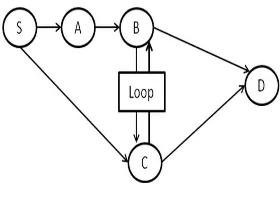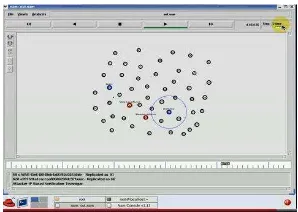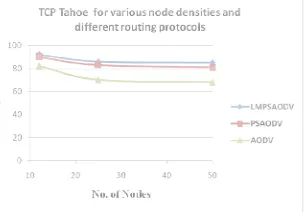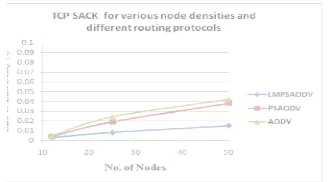Journal of Theoretical and Applied Information Technology 20th June 2014. Vol. 64 No.2
© 2005 - 2014 JATIT & LLS. All rights reserved.
ISSN: 1992-8645 www.jatit.org E-ISSN: 1817-3195
PERFORMANCE OF TCP TAHOE AND SACK OVER
LOOP-FREE MULTIPATH REACTIVE
ROUTING PROTOCOL IN MANET
M.SYED MASOOD1, DR.P.SHEIK ABDUL KHADER2, DR.A.MOHAMED ABBAS3
1,2,3
Department of Computer Applications, B. S. Abdur Rahman University, Chennai, India. Email: 1syedmasood.m1972@gmail.com , 2hodca@bsauniv.ac.in , 3abbasasfaq@gmail.com
ABSTRACT
A few numbers of packets are locked in the network for random time periods may occur due to the mobility of nodes in Mobile Ad hoc networks, “This problem may leads to packet drop, as it stays longer time peri-od in the loop than the allowable Time to Live (TTL) value”. The objective of the paper is to provide Loop-Free Multipath routing to reduce the packet drop and hence the network performance will be enhanced. In this paper, our proposed work of “Loop-free Multipath Probabilistic Scheme based AODV (LMPSAODV)” is simulated using network simulator NS-2.34 to evaluate network performance and the results are present-ed on various scenarios in terms of packet delivery ratio (PDR), total dropppresent-ed packets, routing overhead, end-to-end delay and retransmission rate. The performance will be measured with two different TCP vari-ants namely TCP Tahoe and SACK. Each TCP variant uses different ways of congestion control algorithm. The simulation result shows that “the performance of LMPSAODV with TCP SACK performs better to the changing network sizes”.
Keywords:Loop-Free Multipath, TCP Tahoe, TCP SACK, Packet Delivery Ratio and Routing Overhead.
1. INTRODUCTION
A Mobile Ad hoc Network (MANET) is a wireless multi hop network, in which each node acts as a wireless router that has the capability to forward packets. In MANET the nodes can be dynamically connected by radio waves. The data transmissions between the nodes are without the help of infrastructure, central controller, access point and base station. Recent advances in wireless communication particularly without any fixed infrastructure the research community showing more interest both in comparing the performance of existing routing protocols and improving their performance. Most of the researchers concluded that to improve the performance, cross layered approach gives better result, since, the modifications made in one layer will affect in another layer. In this paper the network layer protocol and transport layer protocol are considered. The performance of different TCP variants will be compared with different versions of AODV.
Sometimes, a few numbers of packets spinning around in the network for arbitrary time periods may occur. This problem may leads to packet drop, as it stays longer time period in the loop than the allowable Time to Live (TTL) value.
In this work, it is developed the Loop-Free multipath routing algorithm in PSAODV routing protocol [12] and evaluation of end to end delay during delivery of packets, routing overhead and Packet Delivery Ratio (PDR) are carried out to enhance the overall performance. These performance metrics evaluation is carried out using TCP Tahoe and by TCP SACK and the results are analyzed, to determine suitable TCP variant for the particular network condition.
In MANET there are three categories of routing protocol for ad-hoc network, namely table driven, on demand and hybrid routing protocols. The on demand routing protocol is also called as reactive routing protocols [1]. In this paper “an improved reactive routing protocol namely LMPSAODV protocol is reported as an experimental study “[2].
reverse link. [5], [6].
TCP which is reliable for end to end transmission is used to deliver the packets from source to destination. There are different TCP variants namely TCP Tahoe, Vegas, SACK, Reno, New Reno and so on [7], [8].
In the routing table to provide the loop-free routes, each router can only pick as successor a neighbor that satisfies the condition that “ it needs to be possible successor by satisfying condition of a flag value; that indicates that whether neighbor nodes forms a loop or not. If the flag value is set to 1; whenever the number of hops value exceeds the allowable limit. Then an alternate path will be provided by selecting another neighbor node”. The routing table will updated based the flag value. In this paper, our proposed work of “Loop-Free Multipath Probabilistic Scheme based AODV (LMPSAODV)” is simulated to evaluate network performance and the results are presented on various scenarios.
2.RELATED WORK
The traditional Ad hoc On-demand Distance Vector (AODV) routing protocol “floods the RouteRequest packet in the network when a route is not available for the desired destination” [9],[10][11]. The Probabilistic Scheme is based on AODV (PSAODV) protocol broadcasts the RouteRequest packet by setting the rebroadcast probability based on the number of neighbors around each node [12]. The main problem associated with TCP Tahoe is that it takes a complete timeout interval to detect a packet loss and leads to more delay. TCP Vegas senses congestion at a very early stage based upon the increased value of rout Trip Time (RTT). RTT is the time required for a packet to travel from a specific source to a specific destination and back again [13].TCP Forward Acknowledgement (FACK) is a special algorithm that works on top of the SACK options [14].
It is stated that, in the QoS field of RREQ and RREP packets, the source host can set this field depends on which QoS level it want [15]. For example, the source host wants to achieve the data rate with 100 kbps; any intermediate nodes which cannot afford such data rate will drop the RREQ or RREP packets when they receiving. Somehow, the source host will receive more than one paths from the destination to the source, if it does not set any QoS requirement, it choose the lowest hop count of path to utilize [15].
An approach is suggested to choose routes
that are relatively short but are formed by nodes that are the farthest possible from the center of the network.
Routing is performed by nodes with limited resources; load should be efficiently distributed through the network. Otherwise, heavily-loaded nodes may make up a bottleneck that lowers the network performances by congestion and larger delays [16].
Another method is proposed to improve the Ad hoc On-demand Distance Vector (AODV) routing protocol to support primary route and alternate route for better QoS and a framework is described based on using QoS parameter in route discovery process that can significantly reduce end-to-end delay and increase packet delivery ratio under conditions of high load and moderate to high mobility [17].
In this paper, an experimental study on the performance of TCP Tahoe and SACK over loop-free multipath reactive routing protocol for MANET is reported.
3. LOOP-FREE MULTIPATH
PROBABILISTIC SCHEME BASED
AODV
In our previous work [12], the Probabilistic Scheme based AODV (PSAODV) to rebroadcast the RouteRequest packets to find a path to the desired destination with reduced routing overhead during data transmission from end to end is proposed for MANETs. As an extension to this work, the Loop-free Multipath Probabilistic Scheme based AODV (LMPSAODV) approach is proposed in this paper to provide disjoint path with reduced routing overhead. The sample scenario for the multipath with cycle is as shown in Figure 1.
[image:2.595.348.488.552.651.2]The packets are started from the source node ‘S’ and it is estimated to reach destination node ‘D’. But, sometimes it is possible that “the packets are locked in the middle nodes ‘B’ and ‘C’ infinitely. In this approach, to provide the loop-free routes, each router pick a neighbor as
successor only if it satisfies the condition that it should not be the common node for another node's transmission range The local route repair concept is similar to that in AODV.
Now, before the TTL period laps the proposed LMPSAODV routing scheme provides an alternate path (that is, node ‘C’ to ‘D’ or node ‘B’ to ‘D’) without beginning the route discovery process. The problem of a small number of packets spinning around in the network for random time periods may happen. Now, TTL values may leads to packet loss. Hence, it is essential to offer an alternate path whenever the loop condition occurred. Multipath routing establishes multiple routes between source and destination nodes. When one route fails due to path break, source nodes can maintain connections by using other routes. So multipath routing protocols can reduce data losses and delay times that are caused by route disconnection. Multipath routing protocols search node-disjoint, link disjoint or non-disjoint routes during the route discovery process”.
4. SIMULATIONS
4.1 Simulation Parameters
[image:3.595.302.517.125.176.2]Simulations are performed using NS-2.34 for a 1000m × 1000m grid consisting of 12, 25 and 50 nodes, distributed randomly over the two-dimensional grid. The source destination pairs are randomly chosen from the nodes in the network. In Random Waypoint mobility model, the mobile nodes travel at a constant speed throughout the entire simulation. The simulation parameter values are given in Table 1. Constant Bit Rate (CBR) traffic is a terminology borrowed from the ATM world. It implies that data are sent at a fixed bit rate, fixed size and a fixed interval between each packet.
Table 1: SIMULATION SETTINGS
PARAMETERS SETTINGS
Transmission range 250 m
Bandwidth 2 Mbps
Simulation Time 300 s
Packet size 512 Bytes
Packet Rate 5 Packet / s
Topology size 1000 m X 1000 m
Number of mobile nodes
12, 25 and 50 nodes
Pause time 0 s, 10s, 20s, 40s and
60s
Traffic type CBR
MAC Protocol IEEE 802.11
Routing protocol AODV, PSAODV,
LMPSAODV
Source Type TCP (Tahoe, SACK)
Mobility model Random Waypoint
NS-2 Version 2.34
[image:3.595.340.489.214.320.2]The initial position of 50 mobile nodes is placed as shown in Figure 2.
Figure 2. Simulation Snapshot
4.2 Performance Metrics
The metrics which are used in this paper are given below:
4.2.1 Packet Delivery Ratio (PDR)
The ratio between the number of packets originated by source and the number of packets received by the destination as in (1).
PDR = Number of Received Data Packets / Number of Sent Data Packets *100
(1)
4.2.2 Drop or packet loss
The routers might fail to deliver some packets if they arrive when their buffers are already full. Some, none, or all of the packets might be dropped, depending on the state of the network and it is impossible to determine what will happen in advance. The receiving application may ask for this information to be retransmitted, possibly causing severe delays in the overall transmission. Packet drop is equal to number of packets sent from source minus number of packet received in the path of destination as in (2).
No. of Packets Dropped = No. of data pkts Sent – No. of data
pkts Received (2)
4.2.3Routing Overhead
In wireless ad hoc networks, nodes often change their location within network. So, some stale routes are generated in the routing table which leads to unnecessary routing overhead. The routing overhead is the total number of control packets transmitted during the simulation time and it can be computed using the equation as in (3).
Total Routing Overhead = No. of Route Request Packets +
No. of Route Reply Packets
(3)
4.2.4 Average End-to-End delay
The average time between sending the packets at the source and receiving the packet at destination. The average end to end delay is computed by Equation (4).
End-to-End delay =
(Time of Packet Arrival at Dest. – Time of Packet Sent at Source) /
Total Number of
Connection Pairs (4)
4.2.5 Retransmission Rate
The TCP retransmission rate can be calculated in two ways. One method is in terms of bytes or in terms of segments. TCP expects acknowledgments from the destination system when it successfully receives segments from the sender. If it does not receive the acknowledgment within a certain time, it will retransmit the segment. To implement this scheme of retransmission, TCP starts a timer for each packet transmitted. Unless the acknowl-edgment is received before this timer expires, TCP will assume that the packet is lost and will re-transmit the packet. The rate at which packets are retransmitted is called the ‘retransmission rate’ and is an indicator of network health. The re-transmission rate can calculate either in terms of bytes or segments. To calculate the byte retrans-mission rate Equation (5) is used.
Retransmission Percentage = (TcpRetransBytes / TcpOutDataBytes) *100 (5)
Retransmission Percentage = 1.467 % The general Retransmission Rules are if retransmissions are less than 10% is moderate, greater than 15% is the warning, greater than 25% is known as excessive retransmissions
and greater than 40% an action is required.
5.RESULTS
The comparison results of AODV, PSAODV and “LMPSAODV” routing protocols are illustrated in terms of the performance metrics namely packet delivery ratio (PDR), total dropped packets, routing overhead, end-to-end delay and retransmission rate by graphs and are discussed below.
5.1 Analysis of Packet Delivery Ratio
[image:4.595.315.507.336.446.2]The packet delivery ratio of AODV, PSAODV and proposed “LMPSAODV” in terms of variation in number of nodes with TCP SACK and TCP Tahoe are as shown in Figure 3and Figure 4respectively.
Figure 3. Packet Delivery Ratio For TCP SACK
Figure 4. Packet Delivery Ratio For TCP Tahoe
The Packet Delivery ratio desires to be high for successful performance of routing. The “LMPSAODV with TCP SACK gives a significant impact in PDR”, because of the AODV does not consider the number of times rebroadcasting the RouteRequest packet and hence it generates more control packets, thus packet drop rate is high.
5.2 Analysis of dropped packets
[image:4.595.346.499.484.592.2]of nodes with TCP Tahoe and TCP SACK are as shown in Figure 5and Figure 6respectively. The dropped packets need to be low for good performance of routing.
Figure 5. No. of packets dropped for TCP Tahoe
Figure 6. No. Of Packets Dropped For TCP SACK
5.3 Analysis of Routing Overhead
The routing overhead of TCP SACK in variation of number of nodes with different routing protocols are as shown in Figure 7, Figure 8 and Figure 9 represents the number Route Request Packets for one communication link, the number Route Reply Packets for one communication link and total routing overhead for one communication link respectively. “The LMPSAODV protocol gives considerable reduction of routing overhead”.
Figure 7. Number Route Request Packets for one communication link
The routing overhead of PSAODV shows the curve decreased significantly compared with
AODV. This is due to AODV broadcasts the RouteRequest packets in simple flooding, whereas PSAODV rebroadcast the RouteRequest packets based on probability
Figure 8. Number Route Reply Packets for one communication link
Figure 9. Total Number Of Routing Overhead Packets For One Communication Link
5.4 Analysis of End-to-End Delay
The End to End Delay is a significant parameter for evaluating a protocol which must be low for good quality performance. The end-to-end Delay in variation with number of nodes for different reactive routing protocols is shown in Figure 10 and Figure 11 with respect to TCP Tahoe and TCP SACK respectively. If the number of nodes increases, the end-to-end delay also increases. This is due to different reasons like mobility speed, number of packets travels in the route and path break.
Figure 11. End-to-end delay for TCP SACK
5.5 Analysis of Retransmission Rate
The performance of “TCP SACK is found to be the retransmission rate of 1.467% packets with the reactive routing protocol LMPSAODV”.
6. CONCLUSION
In the “proposed LMPSAODV routing scheme, the data packets are routed based on PSAODV”. Without performing a route searching procedure, the intermediate nodes can choose another backup path to send data when the routing path is broken or when it is in loop condition using “LMPSAODV”. Thus, the results illustrate that the interaction between transport layer with the network layer protocol has a significant impact on the achievable packet delivery ratio, end-to-end delay and routing overhead in ad hoc networks. Results further shows, that in all instances the quality of service parameters gives 15%-18% improvement in packet delivery ratio with appropriate TCP variant and 45-50% improvement in end-to-end delay and reduced drastically to 40-55% of routing overhead. It is concluded that “the LMPSAODV with TCP SACK performs better to the changing network sizes”.
REFERENCES:
[1] C.Siva Ram Murthy & B.S Manoj, Ad hoc wireless networks-architectures and proto-cols. Pearson Edu. ISBN 0-13-147023-X, 2007, 22 -55.
[2] Yasmin Jahir, Mohammed Atiquzzaman, Hazem Refai & Peter G. LoPresti, ODVH: Ad hoc On-demand Distance Vector Routing for Hybrid Nodes, IEEE ICC 2010 proceed-ings.
[3] B.Dorronsoro, G.Valentini, F.Pinel & P.Bouvry, Optimization of the enhanced dis-tance based broadcasting protocol for MA-NETs. The journal of Supercomputing, 2011.
[4] J.Premalatha. & P.Balasubramanie, Enhanc-ing Quality of Service in MANETs by Effec-tive Routing, IEEE ICWCSC , 2010.
[5] Mohammad Naserian., Mohammad Naserian, Kemal E. Tepe & Mohammed Tarique, Routing Overhead Analysis for Reactive Routing Protocols in Wireless Ad Hoc Net-works.. IEEE. No. 0-7803-9182-9, 2005, 87 – 92.
[6] Muhammad Saleem , Israr Ullah , Syed Ali Khayam & Muddassar Farooq , On the re-liability of ad hoc routing protocols for loss-and-delay sensitive applications. Ad Hoc
Networks. 2011, 285–299.
[7] S.R.Biradar, Subir Kumar Sarkar & C.Puttamadappa , A Comparison of the TCP Variants Performance over different Routing Protocols on Mobile Ad Hoc Networks. In-ternational Journal on Computer Science and Engineering, Vol. 02, No. 02, 2010, 340-344.
[8] Raghuraj Singh, Improving TCP Perfor-mance in Multi Hop Mobile Ad hoc Net-work, International Journal of Elec-tronics and Computer Science Engineering,
ISSN-2277-1956.2012. 109-114.
[9] G.Santhi & Dr.Alamelu Nachiappan, Adaptive QoS Multicast Routing with Mobility Prediction in MANETs. International Jour-nal of Ad hoc, Sensor & Ubiquitous Compu-ting (IJASUC), Vol.1, No.3,2010, 59-70. [10] V. Thilagavathe & Dr. K. Duraiswamy,
Cross Layer based Congestion Control Tech-nique for Reliable and Energy Aware Rout-ing in MANET, International Journal of Computer Applications, Volume 36– No.12, December 2011, 1-6.
[11] M.H.Jiang & R.H.Jan, An efficient multiple-path routing protocol for ad hoc network,
Elsevier Science B. V. Computer Communi-cation, 2002.
[12] Syed Masood M, Sheik Abdul Khader P, ‘Reducing Control Packets through Modified AODV with TCP Tahoe in MANET’, Inter-national Journal of Scientific Research, Vol-ume: 2, Issue: 7, August 2013 , ISSN No 2277 – 8179, Page No. 143 – 146.
[13] M.Jehan , Experimental Evaluation of TCP BIC and Vegas in MANETs, International Journal of Computer Applications, Volume 16, issue 1, 0975 – 8887, 2011,34-38. [14] Debajyoti Pal & Gopal Kundu, Performance
and Computer Science Engineering, ISSN- 2277-1956, 2012, 2296-2300 .
[15] Gao Qian, An Improved on-demand QoS-based routing protocol for mobile ad hoc networks, International Conference on Wire-less Networks and Information Systems,
2009.
[16] Oussama Souihli, Mounir Frikha & Mahmoud Ben Hamouda, Load-balancing in MANET shortest-path routing protocols. Ad Hoc Networks. Elsevier, 2009, 431-442. [17] A.K.Shakeel Ahmed & Ramani, Alternate



